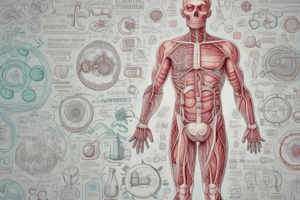Podcast
Questions and Answers
What is the result of xerophthalmia persisting for a long time?
What is the result of xerophthalmia persisting for a long time?
- Keratomalacia (correct)
- Corneal opacities
- Vitamin D deficiency
- Degeneration of conjunctiva
What is the active form of vitamin D?
What is the active form of vitamin D?
- 1,25-dihydroxycholecalciferol (calcitriol) (correct)
- Ergosterol
- Cholecalciferol
- 7-dehydrocholesterol
What is the effect of calcitriol on the bone?
What is the effect of calcitriol on the bone?
- Promotes bone mineralization
- Inhibits calcium absorption
- Causes mobilization of calcium and phosphate from the bone (correct)
- Increases bone demineralization
What is the main function of vitamin A in vision?
What is the main function of vitamin A in vision?
What is the result of vitamin D deficiency in children?
What is the result of vitamin D deficiency in children?
What is the source of vitamin D?
What is the source of vitamin D?
What is the dietary source of preformed vitamin A?
What is the dietary source of preformed vitamin A?
What is the effect of calcitriol on the intestine?
What is the effect of calcitriol on the intestine?
What is the site of absorption of vitamin A?
What is the site of absorption of vitamin A?
What is the form of vitamin A stored in the liver?
What is the form of vitamin A stored in the liver?
What is the protein that transports vitamin A from the liver to peripheral tissues?
What is the protein that transports vitamin A from the liver to peripheral tissues?
What is the antioxidant property of vitamin A attributed to?
What is the antioxidant property of vitamin A attributed to?
What is the major deficiency disease associated with vitamin A deficiency?
What is the major deficiency disease associated with vitamin A deficiency?
What is the characteristic of vitamin A in epithelial cells?
What is the characteristic of vitamin A in epithelial cells?
What is the active form of Vitamin E?
What is the active form of Vitamin E?
What is the primary function of Vitamin K in the body?
What is the primary function of Vitamin K in the body?
What is the consequence of Vitamin C deficiency?
What is the consequence of Vitamin C deficiency?
What is the role of Vitamin K in bone growth and development?
What is the role of Vitamin K in bone growth and development?
What is the function of Thiamine pyrophosphate in the body?
What is the function of Thiamine pyrophosphate in the body?
What is the primary function of Vitamin E in the body?
What is the primary function of Vitamin E in the body?
What is the consequence of Vitamin K deficiency?
What is the consequence of Vitamin K deficiency?
Why can't humans synthesize Vitamin C?
Why can't humans synthesize Vitamin C?
What is the role of thiamine in energy metabolism?
What is the role of thiamine in energy metabolism?
What is the symptoms of Dry beriberi?
What is the symptoms of Dry beriberi?
What is the role of Flavin coenzymes?
What is the role of Flavin coenzymes?
What is the symptoms of Riboflavin deficiency?
What is the symptoms of Riboflavin deficiency?
What is the role of NAD+?
What is the role of NAD+?
What is the symptoms of Wernicke-Korsakoff syndrome?
What is the symptoms of Wernicke-Korsakoff syndrome?
What is the active form of Vitamin B6?
What is the active form of Vitamin B6?
Which vitamin is involved in the synthesis of fatty acid, cholesterol, and steroid hormones?
Which vitamin is involved in the synthesis of fatty acid, cholesterol, and steroid hormones?
What is the result of a prolonged consumption of raw egg whites?
What is the result of a prolonged consumption of raw egg whites?
What is the symptom of Pellagra, a deficiency disease caused by lack of Vitamin B3?
What is the symptom of Pellagra, a deficiency disease caused by lack of Vitamin B3?
What is the role of Vitamin B6 in the body?
What is the role of Vitamin B6 in the body?
Which vitamin is involved in the synthesis of ketone bodies?
Which vitamin is involved in the synthesis of ketone bodies?
What is the consequence of untreated Vitamin B3 deficiency?
What is the consequence of untreated Vitamin B3 deficiency?
What is the symptom of Vitamin B5 deficiency?
What is the symptom of Vitamin B5 deficiency?
Study Notes
Vitamins
- Vitamins are organic molecules essential for normal health and growth, required in trace amounts, and must be obtained from the diet.
Classification of Vitamins
- Vitamins are classified into two main categories: fat-soluble vitamins and water-soluble vitamins.
Fat-Soluble Vitamins
Vitamin A
- Occurs in two forms: preformed (active form) and provitamin A.
- Found in animal and plant tissues, respectively.
- Converted to retinoids form in the intestine.
- Has a beta-ionone ring, which is essential for its function.
- Functions: vision, reproduction, antioxidant, and growth.
- Deficiency: night blindness, Bitot's spots, xerophthalmia, keratomalacia.
Vitamin D
- Also known as the "sun-shine vitamin".
- Derived from 7-dehydrocholesterol or ergosterol by UV radiation.
- Active form: 1,25-dihydroxycholecalciferol (calcitriol).
- Functions: promotes calcium and phosphate absorption in the intestine, bone mobilization, and kidney reabsorption.
- Deficiency: rickets (children) and osteomalacia (adults).
Vitamin E
- Exists in eight chemical forms: tocopherol and tocotrienol.
- Active form: α-tocopherol.
- Functions: prevents free radical damage to polyunsaturated fatty acids and reduces oxidative damage to LDLs.
- Deficiency: hemolytic anemia, peripheral neuropathy, and increased risk of cardiovascular diseases.
Vitamin K
- Exists in two natural forms: vitamin K1 (phylloquinone) and vitamin K2 (menaquinone).
- Functions: necessary for coagulation of blood, bone growth, and development.
- Deficiency: hemorrhagic disease and osteoporosis.
Water-Soluble Vitamins
Vitamin C (Ascorbic acid)
- Most animals can synthesize ascorbic acid, but humans cannot due to a deficiency of L-gulonolactone oxidase.
- Functions: hydroxylation of proline and lysine, antioxidant, enhances iron absorption, and role in tryptophan and tyrosine metabolism.
- Deficiency: scurvy, characterized by bleeding gums, bruising, and poor wound healing.
Vitamin B1 (Thiamine)
- Active form: thiamine pyrophosphate.
- Functions: cofactor for pyruvate dehydrogenase, α-ketoglutarate dehydrogenase, and transketolase.
- Deficiency: beriberi (wet and dry), Wernicke-Korsakoff syndrome.
Vitamin B2 (Riboflavin)
- Active forms: flavin mononucleotide (FMN) and flavin adenine dinucleotide (FAD).
- Functions: involved in mitochondrial respiratory chain, fatty acid and amino acid oxidation, and citric acid cycle.
- Deficiency: glossitis, cheilosis, angular stomatitis, and corneal vascularization.
Vitamin B3 (Niacin)
- Active forms: nicotinamide adenine dinucleotide (NAD+) and nicotinamide adenine dinucleotide phosphate (NADP+).
- Functions: important for ATP production by the respiratory chain and biosynthetic reactions.
- Deficiency: pellagra, characterized by dermatitis, diarrhea, and dementia.
Vitamin B7 (Biotin)
- Acts as coenzyme for carboxylation reactions.
- Deficiency: dermatitis, atrophic glossitis, hair loss, muscle pain, anorexia, and hallucinations.
Vitamin B5 (Pantothenic Acid)
- Component of coenzyme A (CoA), which has numerous functions in carbohydrate, lipid, and amino acid metabolism.
- Deficiency: burning foot syndrome, characterized by paresthesia, staggering gait, and sleep disturbances.
Vitamin B6 (Pyridoxine)
- Exists naturally in three forms: pyridoxine, pyridoxal, and pyridoxamine.
- Active form: pyridoxal phosphate (PLP).
- Functions: cofactor for transamination, deamination, formation of cysteine from methionine, heme synthesis, and decarboxylation reactions.
- Deficiency: neurological manifestations, including seizures, depression, confusion, and peripheral neuropathy.
Studying That Suits You
Use AI to generate personalized quizzes and flashcards to suit your learning preferences.
Related Documents
Description
Learn about the classification, functions, and deficiency diseases of vitamins, including vitamin B complex, in the context of medical biochemistry.




